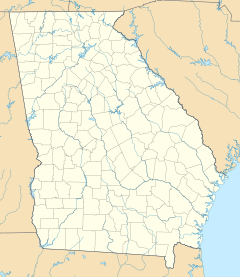Tybee Island Light Station
 |
|
|
Georgia
|
|
| Location | Tybee Island, Georgia |
|---|---|
| Coordinates | 32°01′20″N 80°50′44″W / 32.02223°N 80.84566°WCoordinates: 32°01′20″N 80°50′44″W / 32.02223°N 80.84566°W |
| Year first constructed | 1736 |
| Year first lit | 1867 |
| Automated | 1972 |
| Foundation | Stone and timber |
| Construction | Brick |
| Tower shape | Octagonal |
| Markings / pattern | lower 50 feet (15 m) black, upper part white; lantern, black |
| Height | 144 feet (44 m) |
| Original lens | 1791:Oil lamps; 1867:First order Fresnel lens |
| Current lens | First order Fresnel lens |
| Range | 16 nautical miles; 29 kilometres (18 mi) |
| Characteristic | Fixed white |
| Admiralty number | J2776.1 |
| ARLHS number | USA-864 |
| USCG number | 3-0345 |
Tybee Island Light is a lighthouse next to the Savannah River Entrance, on the northeast end of Tybee Island, Georgia. It is one of seven surviving colonial era lighthouse towers, though highly modified in the mid 1800s.
The current lighthouse is the fourth tower at this station, though neither of its first two predecessors were lit. The first tower was built at the direction of James Oglethorpe and was constructed of wood; erected in 1736, it was felled by a storm in 1741. The following year a replacement was erected, this time of stone and wood, but still without illumination; instead, it was topped with a flag pole. This tower succumbed to shoreline erosion.
The third tower was constructed in 1773 by John Mullryne, a brick tower originally 100 ft (30 m) in height. It was first fitted with a system of reflectors and candles, but this was upgraded to oil lamps after it was ceded to the federal government in 1790. A second tower was added to the site in 1822 to form a range. Both towers received Fresnel lenses in 1857, with the lower front tower being equipped with a 4th order lens, while the main tower received a larger 2nd order lens.
Confederate forces burned the light in 1862 during the Civil War and removed the lens as they retreated to Fort Pulaski. Reconstruction of the light was begun in 1866 but was delayed by a cholera outbreak. A new tower was constructed atop the first 60 ft (18 m) of the old tower, raising the height of the whole to 154 ft (47 m). This tower was equipped with a 1st order lens. The front beacon was now a 50 ft (15 m) wooden skeleton tower equipped with a new 4th order lens.
The main tower was severely damaged in a hurricane in 1871, and developed such serious cracking that a $50,000 appropriation was requested for its replacement. Instead a new front tower (which had already been moved twice) was constructed of iron. New keepers dwellings were constructed in 1881 and 1885. The following year the tower was shaken by the 1886 Charleston earthquake, which damaged the lens and caused further cracking of the brickwork; these were both however immediately repaired. In 1933 the tower was electrified and the station reduced to a single keeper. The beacon was automated in 1972.
...
Wikipedia

